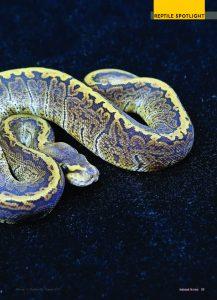The next spectacular ball python morph Animal Scene has for its faithful herpetologist readers is the striking Cinnamon pin or GHI cinnamon pin ball python. An elegant-looking morph with a pattern that seems commissioned by fashion designers, the Cinnamon pin is one of the more uncommon morphs, derived from a combination of three morphs: the amusingly-named GHI (short for “Gotta Have It”), the cinnamon, and the pinstripe. We asked python expert Larry Tan about this beautiful morph.
Mighty Morphing Python Rangers
A big reason for the ball python’s popularity is the wide array of morphs, or inheritable visual traits, that this species of snake has exhibited. From the singular wild type, also known as the “Normal” within the keeper community, dozens of other morphs have emerged. Some morphs are dominant, like the spider, pinstripe, or the aforementioned normal morphs. Other morphs such as the pastel or Mojave, are co-dominant, which means that a snake will exhibit one appearance if it receives one co-dominant gene, and another appearance if it receives a matched pair from its parents.
Finally, many morphs are recessive, which means that a snake must receive a matched gene pair before it exhibits a visual difference. Axanthics, albinos, Toffees, and Toffinos are a few examples of recessive ball python morphs.
Therefore, understanding what a morph is, is vital for would-be herpetologists, because it is basic knowledge in the genetics of ball python breeding. A morph is a trait that manifests as a distinctly different appearance from the Normal type. That trait must be inheritable, which means that it should be a trait that is capable of being passed down from one generation to another.

“Based on the features of the 3 separate base morphs,” Larry explains, “you sort of have to try and see if these features have been passed on. Some features are rather evident, some are very subtle, and in some cases, they are impossible to tell. In the case of the cinnamon pin, there are only 3 morphs involved in the combination, so it’s still rather easy. The pinstripes are the most obvious, but these are still altered by the GHI gene and the cinnamon gene. Because I have previously produced a cinnamon pinstripe as well as a cinnamon GHI, I can deduce with high certainty that this is a GHI cinnamon pinstripe.”
All the morphs that go into making a cinnamon pin are incomplete-dominant or co-dominant traits, which means that these 3 morphs have a “super form,” which occurs when an incomplete dominant gene is doubled up, producing the complete-homozygous expression of the incomplete dominant gene.
“As long as the parents that you use have all 3 morphs,” Larry continues, “then it is possible to produce a GHI cinnamon pinstripe. The most cost-effective way to do this is to have a GHI male paired with a female cinnamon pinstripe.”
Larry loves the way that the other 2 morphs alters the way the pinstripe morph expresses itself. “I personally like how the pinstripes really get busier,” he explains. “Besides the fact that I love the way the cinnamon pin already looks, this baby is already set to match up with some even nicer looking babies. We keep the details of this sort of thing under wraps, so please watch out for what we have lined up for you next!” He’s promised to share the results with Animal Scene when it happens.
Ball Python Basics
The ball python, known by its scientific name Python regius, is the most commonly kept snake in the world, and is popular with snake handlers of all experience and skill levels. This is because ball pythons come in a dizzying array of colors and patterns that vary significantly from the wild type (the Normal).
Ball pythons are compact snakes, with adult females measuring 3-5 feet, while adult males average 2-3 feet. They are available from many breeders and pet stores, and are relatively easy to care for. The ball python is native to central and western Africa, and thrive in warm, tropical environments, but they have made their way to every continent except Antarctica, and are called the “Royal Python” in Europe.

The care of morphs is just like the care of any other ball python, says Larry. These snakes require either a terrarium or a rack system with a warm side and a cool side to help them regulate their body temperature, since snakes are cold-blooded. They also need a hiding place on both sides to help them feel safe.
Morphs, like all ball pythons, are relatively clean creatures and can live in most beddings or substrates, even newspapers. Cedar shavings are not good beddings for snakes, however, as the volatile oils within the shavings can cause skin, respiratory, and reproductive system damage. Also, avoid collecting your substrates from the wild, as they may contain organisms that are harmful to your morph.
This appeared in Animal Scene magazine’s October 2017 issue.





